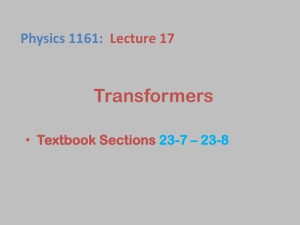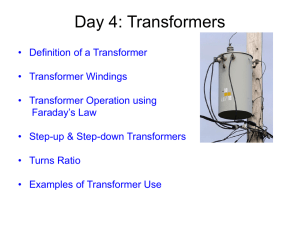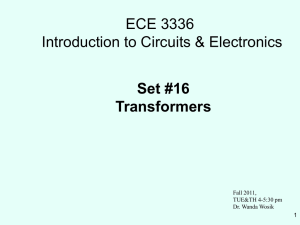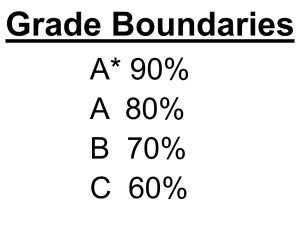Chapter23
advertisement
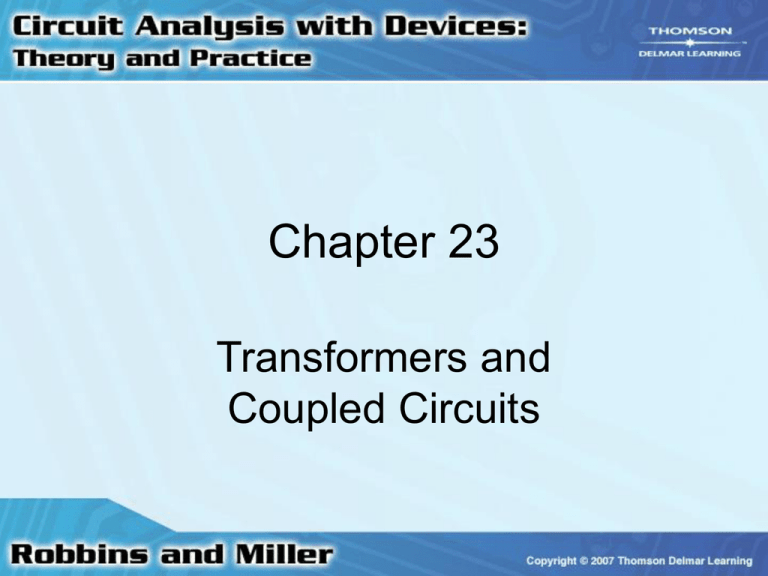
Chapter 23 Transformers and Coupled Circuits Transformer Construction • Transformer is a magnetically coupled circuit • It consists of two coils wound on a common core 2 Transformer Construction • Power flows from one circuit to the other circuit – Through the medium of the magnetic field 3 Transformer Construction • There is no electrical connection between the two coils • Coil (winding) on side of the transformer to which we apply power is called primary 4 Transformer Construction • Coil on side to which we connect the load is called the secondary 5 Transformer Construction • Iron-core transformers – Generally used for low-frequency applications (such as audio and power) • Iron core provides an easy path for magnetic flux 6 Transformer Construction • Two basic construction types – Core and shell • Each type uses laminated sheets of metal to reduce eddy currents 7 Transformer Construction • Air-core and ferrite-core types – Used for high-frequency applications (such as radio frequencies) 8 Transformer Construction • These do not have high hysteresis and eddy-current losses of iron-core transformers • Ferrite – Increases coupling between coils while maintaining low losses 9 Transformer Construction • Transformer may be used to change polarity of an ac voltage – Depending on the directions of its windings 10 Transformer Construction • If most of the flux produced by one of the coils links the other – Coils are tightly coupled – Otherwise loosely coupled • All transformer operations are described by Faraday’s law 11 Voltage Ratio for Ideal Transformers • If we apply Faraday’s law, where N is the number of turns and is the flux, then ep N p es N s ep es t t Np Ns 12 Voltage Ratio for Ideal Transformers • Ratio of primary voltage to secondary voltage – Equal to ratio of the number of turns 13 The Turns Ratio • Turns ratio (or the transformation ratio) – a = Np/Ns • Also, ep/es = a 14 The Turns Ratio • A step-up transformer – Secondary voltage is higher than the primary voltage (a < 1) • A step-down transformer – Secondary voltage is lower (a > 1) 15 The Current Ratio • In an ideal transformer – Power in equals power out (η = 100%) • Ratios of the current are e p i p es i s ip es 1 i s ep a 16 The Current Ratio • If voltage is stepped up – Current is stepped down, and vice versa 17 Reflected Impedance • A load impedance ZL connected directly to a source is seen as ZL • Impedance will be seen by the source differently – If a transformer is connected between the source and the load 18 Reflected Impedance • Reflected impedance, Zp, is given by – Zp = a2ZL 19 Reflected Impedance • Load characteristics do not change – Capacitive loads still look capacitive, etc. • A transformer can make a load look larger or smaller – Depending on the turns ratio 20 Reflected Impedance • Using a transformer – We can match loads to sources (such as amplifiers) • Relates to the maximum power theorem discussed in a previous section 21 Transformer Ratings • Transformers are rated in terms of voltage and apparent power • Rated current can be determined from these ratings 22 Transformer Ratings • By dividing the apparent power rating by the voltage rating – Rated current is determined, regardless of the power factor 23 Power Supply Transformers • Used to convert the incoming 120 V source to voltage levels required by circuit • Some have a multi-tapped secondary winding to provide different voltages for different applications 24 Power Supply Transformers • Typically, an incoming voltage is – Stepped down – Rectified – Smoothed by a filter – Passed through a voltage regulator 25 Transformers in Power Systems • Transformers are used at generating stations to raise voltage for transmission – This lowers losses in the transmission lines • At the user end – Voltage is stepped down 26 Transformers in Power Systems • Transformers have a split secondary – This permits both 120-V and 240-V loads to be supplied from the same transformer • For residential use – Single phase is used 27 Isolation Applications • Transformers are sometimes used to isolate equipment • Isolation transformers are often used to make measurements involving high voltages 28 Isolation Applications • They can also ensure that a grounded metal chassis is not connected to a hot wire 29 Isolation Applications • Readings can be made on an oscilloscope – Must have a grounded lead without shorting circuit components across ground connections by using a 1:1 transformer 30 Impedance Matching • A transformer can be used to raise or lower apparent impedance of a load • Impedance matching – Sometimes used to match loads to amplifiers to achieve maximum power transfer 31 Impedance Matching • If load and source are not matched – A transformer, with the proper turns ratio, can be inserted between them 32 Autotransformers • In autotransformers – Primary circuit is not electrically isolated from its secondary – They cannot be used as isolation transformers 33 Autotransformers • Smaller and cheaper than conventional transformers with the same load kVA 34 Practical Iron-Core Transformers • Non-ideal transformers have several effects that cause loss of power • Leakage flux – Will appear as small inductances in series with the windings 35 Practical Iron-Core Transformers • Winding resistance • Core losses due to eddy currents and hysteresis • Magnetizing current 36 Transformer Efficiency • Efficiency is ratio of output power to input power – Given as a percentage. • Losses – Due to power losses in the windings and in core 37 Transformer Efficiency • Large transformers can have efficiencies of 98 to 99 percent • Smaller transformers have efficiencies of about 95 percent 38 Transformer Tests • Losses may be determined by making tests on transformers • Short-circuit tests – Determine losses due to resistance of windings • Open-circuit tests will determine core losses 39 Voltage and Frequency Effects • As applied voltage increases, core flux increases, causing greater magnetization current – Therefore, transformers should be operated only at or near their rated voltage 40 Voltage and Frequency Effects • At very low frequencies – Core flux and the magnetizing current increases • Causing large internal voltage drops • At very high frequencies – Stray capacitances and inductances cause voltage drops 41 Loosely Coupled Circuits • Circuits without an iron core, where only a portion of the flux produced by one coil links another • Cannot be characterized by turns ratios – They are characterized by self- and mutual inductances 42 Loosely Coupled Circuits • Expressed by coefficient of coupling – Air-core – Ferrite-core transformers – General inductive circuit coupling 43 Loosely Coupled Circuits • Self-induced voltage in a coil is – v = L di/dt • Mutually induced voltage of a coil is – v = M di/dt – M is mutual inductance between coils 44 Loosely Coupled Circuits • In each coil – Induced voltage is the sum of its self-induced voltage – Plus voltage mutually induced due to the current in the other coil 45 Loosely Coupled Circuits • Coefficient of coupling, k – Describes degree of coupling between coils • Mutual inductance depends on k: M k L1L2 46 Loosely Coupled Circuits • Coupled impedance is Z in Z p M 2 Zs ZL 47

